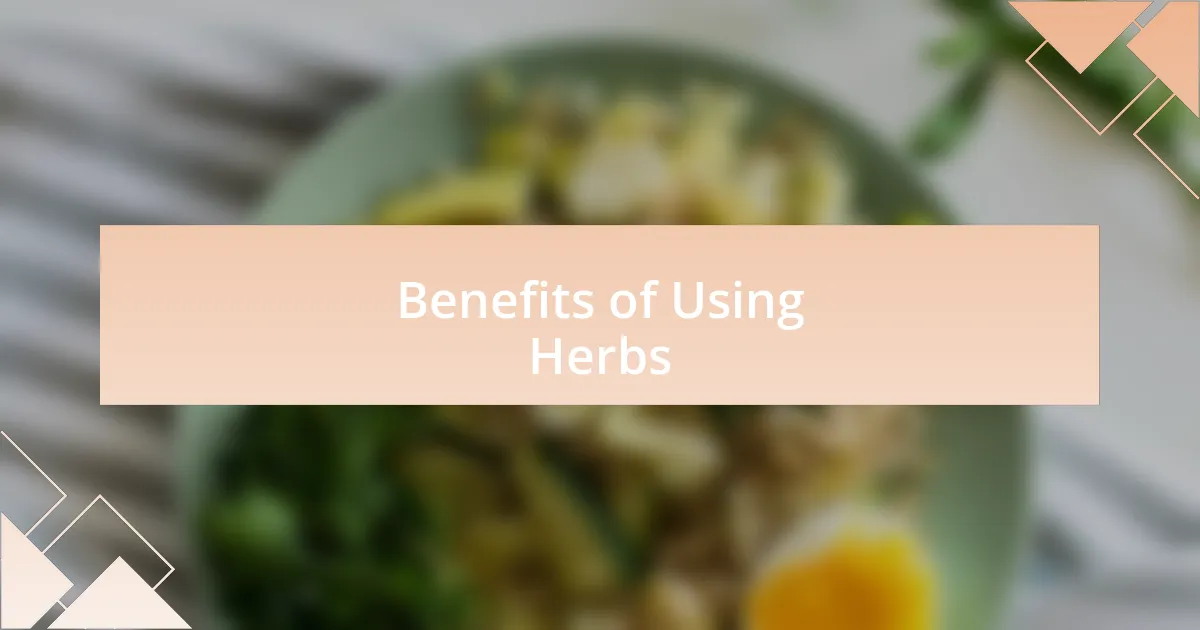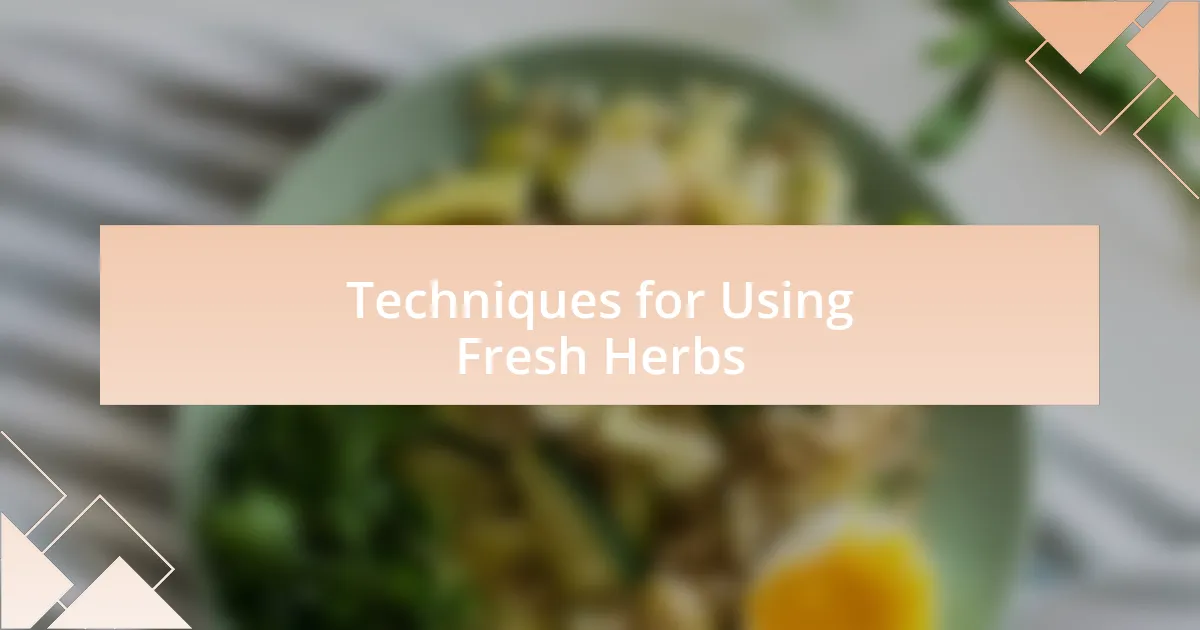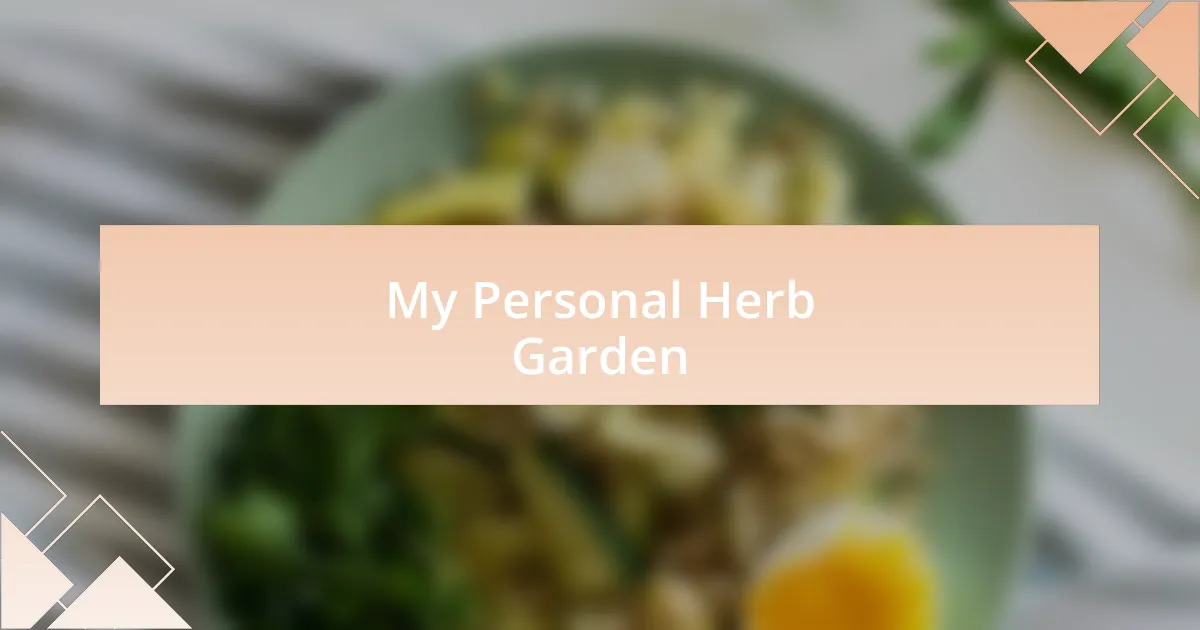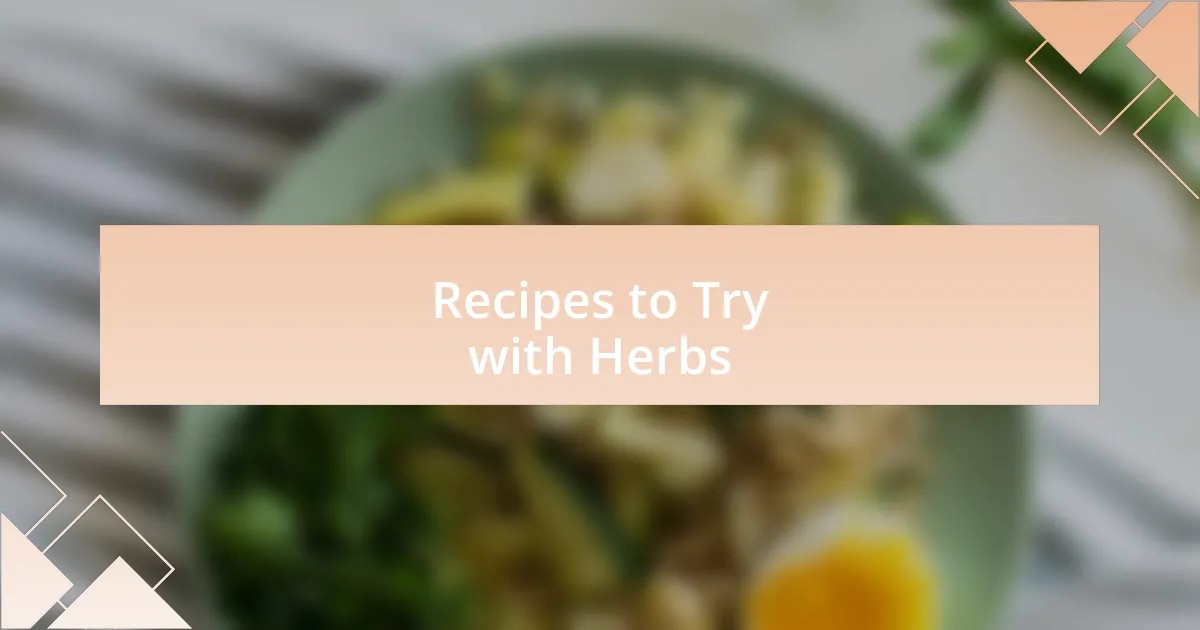Key takeaways:
- Culinary herbs enhance flavor, evoke memories, and create a deeper connection to cooking experiences.
- Using fresh and dried herbs involves specific techniques, like timing and rehydration, to maximize their flavor impact.
- Personal herb gardening offers joy and inspiration, as it connects one with nature and cherished memories.
- Recipes featuring herbs, such as herbed chicken, chimichurri, and pesto, showcase their versatility and elevate simple meals.

Understanding Culinary Herbs
Culinary herbs are more than just garnish; they serve as the heart of flavor in many dishes. I often find myself reminiscing about the first time I tasted fresh basil straight from the garden. The burst of sweetness took me by surprise, making me wonder how something so simple could elevate a meal so dramatically.
When it comes to understanding herbs, it’s essential to recognize that each variety carries its own unique personality. Take rosemary, for instance. Its musky aroma isn’t just pleasant; it’s a reminder of family dinners where roasted lamb was always a centerpiece. Isn’t it fascinating how certain scents can evoke memories and feelings tied to specific experiences?
It’s crucial to learn how to pair herbs with the right ingredients. For example, I’ve experimented with dill in various recipes, and I often ask myself—what makes it resonate so well with seafood or yogurt? Discovering these pairings has not only enhanced my cooking but also deepened my appreciation for the role herbs play in crafting memorable flavors.

Benefits of Using Herbs
Using herbs in cooking offers a myriad of benefits that go beyond just flavor enhancement. When I first started using fresh cilantro in my dishes, I was amazed at how it could brighten up even the simplest recipes. It made me wonder—what other herbs could elevate my meals in a similar way?
Beyond flavor, incorporating herbs like thyme and oregano brings a healthful twist to our plates. For instance, I remember a time when I sprinkled fresh oregano on a homemade pizza, and not only did it taste wonderful, but I also felt a sense of accomplishment knowing I was adding benefits such as antioxidants and essential vitamins. Isn’t it satisfying to nourish both the palate and the body?
Herbs can also transform the cooking experience itself. The process of chopping fresh parsley or tearing basil leaves often serves as a meditative moment for me in the kitchen. This not only enhances my dishes but allows me to engage fully with the cooking process. Why wouldn’t you want to add such vibrant energy to your meals?

Types of Common Culinary Herbs
Herbs can be broadly classified into two categories: leafy and woody. Leafy herbs, such as basil, cilantro, and parsley, add a fresh touch to dishes with their vibrant flavors. I distinctly remember experimenting with basil in a simple caprese salad; the fragrance alone sparked a sense of joy and transformed my understanding of what fresh ingredients could do.
On the other hand, woody herbs like rosemary, thyme, and sage have sturdier stems and a more robust flavor profile. I often use rosemary in roasted chicken, and I find it pairs beautifully with garlic, creating an aroma that fills my kitchen with warmth. Have you ever noticed how some herbs seem to tell a story through their scent?
Additionally, herbs like mint and dill bring brightness and complexity to various cuisines. I once made a refreshing cucumber salad with a sprinkle of dill, and the coolness of that dish was nothing short of a summer day on a plate! These herbs not only elevate flavors but also remind me of the places and memories intertwined with the meals I create. How do you see herbs enhancing your culinary experiences?

Techniques for Using Fresh Herbs
When using fresh herbs, timing can significantly impact their flavor. Adding delicate herbs like basil or cilantro at the end of cooking ensures they maintain their bright profiles. I recall once tossing fresh basil into a steaming pot of pasta just before serving. The vibrant aroma wafted through the kitchen, elevating the dish almost instantly. Have you ever experienced that magical moment when a simple ingredient transforms the entire meal?
Another technique I find effective is bruising herbs—gently crushing them—before incorporating them into dishes. This process releases essential oils and intensifies the flavors. I often do this with rosemary when making a marinade; it adds an extra layer of depth that just chopping doesn’t achieve. It’s like giving the herbs a little wake-up call, drawing out their personalities to shine in the dish!
Moreover, consider using fresh herbs as garnishes to enhance presentation and flavor. A sprinkle of chopped parsley over a hearty stew can make an ordinary dish feel gourmet. I’ve served roasted vegetables adorned with fresh thyme, and it never fails to impress my guests. It’s fascinating how a little green can make a plate look inviting, don’t you think?

Techniques for Using Dried Herbs
When working with dried herbs, rehydration is a useful technique I often employ. Soaking dried herbs in warm water or broth before adding them to a dish helps to release their flavors more effectively. I remember making a lentil soup and allowing the dried thyme to sit in broth while I prepped the other ingredients. The depth it added to the final dish was remarkable—almost as if the herbs were singing their flavors back into life.
Another technique I find interesting is the timing of when to add dried herbs. Unlike fresh herbs, dried ones benefit from early incorporation in the cooking process. I once prepared a slow-cooked ragu, and adding dried oregano at the beginning allowed its flavors to meld perfectly with the sauce, creating a rich, savory base. It’s similar to a symphony where every note has its place, don’t you think?
Finally, I like to experiment with combining different dried herbs to create unique flavor profiles. Mixing rosemary and sage gives a delightful earthy aroma to roasted meats. I remember crafting a herb blend for a holiday roast— the aroma filled my kitchen, and I could see the eyes of my family lighting up in anticipation. Such moments remind me how dried herbs can elevate our cooking adventures in unexpected ways.

My Personal Herb Garden
When I decided to start my own herb garden, excitement buzzed through me like a spark. I chose a small patch by my kitchen window, a space that would soon transform into a rainbow of fresh greens. I remember the first time I harvested basil; the scent was intoxicating, reminding me of summer evenings spent cooking with my grandmother. It struck me—growing my own herbs wasn’t just about spices; it was about reconnecting with cherished memories.
Tending to my garden became a meditative practice as I discovered the joy of nurturing life. I found myself learning the delicate balance of sunlight and water while watching the herbs flourish. One hot day, I stood outside watering my mint, and the vibrant green leaves glistened under the sun, whispering possibilities for refreshing drinks and salads. Isn’t it incredible how plants can brighten not just a dish, but also one’s spirit?
Every harvest feels like a mini celebration, especially when I bring freshly cut herbs into my kitchen. The sight of vibrant parsley, fragrant rosemary, and delicate chives always inspires me to experiment. Just last week, I incorporated fresh dill into a creamy potato salad, and the flavors danced on my tongue. Each time I create something new, I wonder—how has it taken me this long to embrace my herb garden fully?

Recipes to Try with Herbs
When I think about recipes to showcase my homegrown herbs, a standout is my herbed chicken roasted with thyme and rosemary. I remember the first time I made it; the kitchen filled with the aroma of herbs mingling with garlic. It’s as if those scents wrapped around me, inviting everyone to the dinner table. Have you ever noticed how a well-seasoned dish can turn an ordinary meal into a special occasion?
Another favorite recipe is my vibrant chimichurri sauce, which I whip up with fresh parsley and cilantro. The colors pop like a summer garden, and I love drizzling it over grilled meats or tossing it with roasted vegetables. Preparing this sauce always brings a smile to my face—it feels like a little burst of sunshine, enhancing even the simplest meals. Have you tried making sauces from your herbs? The difference in flavor is phenomenal!
For a quick snack, I often blend basil into a classic pesto. Just the sight of that vivid green paste in the blender energizes me. It reminds me of lazy Sundays spent making homemade pasta with friends. There’s something magical about the simplicity of fresh ingredients transforming into a delightful dish that makes sharing food so rewarding. Have you ever tried making your own pesto? I can assure you, once you do, you’ll never want store-bought again!